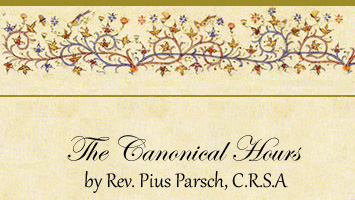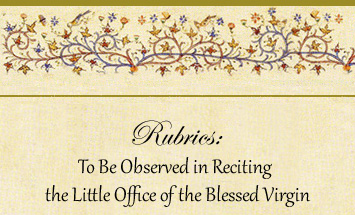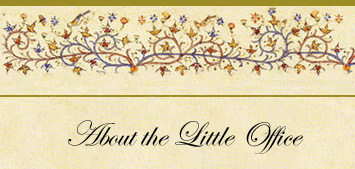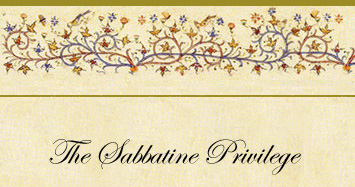The Little Ofiice of the Blessed Virgin Mary is of ancient usage in the Church; and was recited by the clergy and devout laity, and practised by rule in religious monasteries, even from the sixth and seventh centuries, and probably at a more early period, as Meratus observes in his annotations on Gavantus.
This Office was instituted by the Church, guided by the
Spirit of God, and is divided into seven canonical hours, according to the following order, set down in the Roman Breviary:--1st, Vespers; 2nd, Complin; 3rd, Matins with Lauds; 4th, Prime; 5th, Terce; 6th, Sext; and 7th, None. A more detailed explanation of the Canonical Hours is provided below.
The Little Office of the Blessed Virgin Mary is always of a simple rite, and as such, it should be recited every day, and invariably observed the whole year round. The simple rite signifies--1st, That the office commence at Vespers, and terminate at None;--2nd, That there be said only one nocturn at Matins, the psalms are changed according to the order of the days;--3rd, That when the commemoration of a Patron Saint is made, it should be at Vespers and Lauds, between the prayer which follows the Magnificat and the Benedictus, and the Commemoration of Saints.;--and 4th, That the anthems of the psalms be simple, viz., that the first words only of the anthems be said before the psalms, but after the psalms the anthems recited entire. When anthems are recited as of double rite, all the Antiphons to the Psalms and Canticles have to be said in full before and after.
The anthems, prayers, and lessons of this Office are
changed at different times in the year, viz., in Advent, at Christmas time, in Paschal time, and the rest of the year. The office in Advent begins at Vespers on Saturday before the first Sunday of Advent, till None on Christmas-eve: the office at Christmas time begins at Vespers on the vigil of Christmas, till Vespers on the 2nd of February, feast of the Purification of the Blessed Virgin Mary: the common office begins at Matins on the 2nd of February, till None on Saturday before the first Sunday in Advent. Paschal time is from Vespers on Easter Saturday, till None on Saturday in Whitsun-week before Trinity Sunday.
In Order to promote true piety towards the Blessed Virgin Mary and to encourage the devout recital of her office, the following indulgences have are granted to the faithful according to the 1910 Raccolta:
II. Plenary, once a month. (Special Conditions: Confession, Communion.)
III. 300 Days, once a day, for Matins and Lauds only,
IV. 50 Days, for each Little Hour, for Vespers, and for Compline.
The Indulgences attached to this Office are extended to the recitation of it in the vernacular only in case of private recitation.
Private recitation includes recitation by communities in their private chapels or even in their churches, if the doors are closed to the public.

The Church lives in time and with time. This truth is brought out beautifully in the canonical hours. They provide a perfect way to consecrate the whole day to God and make it holy. The admonition of our Lord, that we are to pray and not grow weary, is thus perfectly fulfilled. For every part of the day the Church has drawn up a special prayer-form, an hour, as it is called, that corresponds to the particular need of that time of the day. The day is like a journey through an arid desert, but every three hours we come upon an oasis that offers us the waters of grace and the cool refreshing shade of heavenly assistance. Spiritually we may revive ourselves at the canonical hours of prayer.
In order to understand what these divisions of the day are supposed to mean, it would be well to take a brief but thorough look into the history of their development. In the early centuries of the Church, in addition to the celebration of Mass, it was customary to hold a so-called vigil, which was a prayer service in three parts, on the night before a feast day. From this vigil service developed three of our canonical hours: Vespers, Matins, Lauds, inasmuch as the first was prayed the preceding evening, and the last was held in the early hours of the morning. This was the arrangement already in the days of Hippolytus (†236) and these were the first "hours." In the Roman office the threefold division of Matins was re-introduced even after the vigil service had split into Vespers, Matins, and Lauds, and the divisions came to be known as nightwatches or nocturns.
Corresponding to the three nocturns of Matins there are three daytime hours, Terce, Sext, and None. This makes three nocturns or nightwatches, three day hours, morning prayer (Lauds) and evening prayer (Vespers). The whole day is thereby sanctified in its principal divisions. There are and always have been Christians who actually pray these "hours" at their corresponding times.
The two remaining hours were added later, under the influence of monasticism. The monks prayed Matins during the night and said Lauds (morning prayer) in the early dawn, then went back to bed. When they rose later to begin the day's work, they felt the need for some common service to consecrate their labours to the Lord. Thus they developed Prime, a sort of second morning prayer. Vespers (evening prayer) were said in late afternoon, and then at bedtime there were devotions in the sleeping quarters (lessons, chapter of faults, abbot's blessing), which developed into Compline, a sort of second night prayer. With the addition of Compline, the development of the canonical hours came to an end.

(I) The ordinary form of the Office begins at Matins the day after the Purification.
(II) The Advent Office begins with the Vespers of the Saturday before the first Sunday of Advent.
(III) The Christmas Office begins with the first Vespers of the Vigil of Christmas and continues until after Compline of the Purification.
2. When Lauds are said immediately after Matins the Ave Maria (Hail Mary) before the Deus in adjutorium (O God, + hasten to mine aid) is omitted.
3. When the Office is said in private, the Anthem of the Blessed Virgin is said after Lauds and Compline only, unless the Little Hours follow immediately after Lauds; then the Anthem is said after the last Hour. The Little Hours end with an Ave Maria when they are said separately from Lauds or from one another. Vespers are also terminated by an Ave Maria when they are separated from Compline.
4. When the Office is said in public and discontinued after the recital of one of the Hours, the Anthem of the Blessed Virgin is always said.
5. If one or more of the Little Hours is said immediately after Lauds, the Pater and the Versicle which follow Fidelium animae, etc., are said only after the last Hour.
6. The Anthem of the Blessed Virgin is said standing during Paschal time, and from the Vespers of Saturday until after the Compline of Sunday. At all other times it is said kneeling.
7. The Te Deum is said from Christmas to Septuagesima Sunday, and from Easter to Advent. During the remainder of the year it is said only on the feasts of the Blessed Virgin and on the feast of St. Joseph.
8. On the feast of the Annunciation the Office is said as in Advent.
9. When the feast of the Purification occurs after Septuagesima Sunday, the Te Deum may be said. If this feast is transferred the alteration in the Office is not transferred with it.
10. From Septuagesima Sunday to Vespers on Holy Saturday, Laus tibi, Domine, etc., is said instead of Alleluia.
11. In Passion-time the Gloria is to be said as usual. During the last three days of Holy Week the Little Office is not recited publicly.
12. In Paschal-time the Office is the same as that before Advent; but after the Benedictus, the Magnificat, and the Nunc Dimittis the Anthem Regina Caeli is said. During this time the Alleluia is not said after the Invitatory, Versicles, or Responses. Paschal-time begins with Compline of Holy Saturday, and ends at None of the Saturday after Pentecost.
13. The Anthem Regina Caeli is said for the first time after the Nunc Dimittis on Holy Saturday, and for the last time at Lauds of the Saturday before Trinity Sunday.
14. From the Compline of the Purification, the Anthem Ave Regina is said instead of the Alma Redemptoris.
15. When the commemoration of a Patron Saint is made, it should be at Vespers and Lauds, between the prayer which follows the Magnificat and the Benedictus, and the Commemoration of Saints.
16. As a rule, in the recitation of the Little Office of the Blessed Virgin Mary the Antiphons of the Psalms are announced in the manner that is proper to an Office of simple rite, i.e. only the first words (preceding the asterisk *) of the Antiphons are said before the Psalms, but the entire Antiphon is recited after the Psalms. When exceptions are made and Antiphons are recited as of double rite, all the Antiphons to the Psalms and Canticles have to be said in full before and after.

The most important illuminated manuscript of the 15th century was the Tres Riches du Duc de Berry. It accompanied the Book of Hours of which the most essential text was the Little Office of the Blessed Virgin Mary. The paintings were made between 1412 and 1416 by the Limbourg Brothers (Herman John, and Paul) commissioned by their patron, Jean Duc de Berry, who was one of the greatest art patrons of all time. The Duc de Berry did more than collect the Book of Hours--he used them extensively in his own life for personal devotions. The Dutch miniatures were made in the style known as International Gothic known for realism, landscapes and ornamentation.
The three Limbourg brothers were believed to be 16 to 19 years old at the
start of their employment for the Duc de Berry. Their allegiance to him lasted
until their early deaths--possibly due to the plague--when they were in their 30's. The brothers mixed their own paints from the highest quality materials, all of which were provided by their generous patron who spared no expense. These paints were exuberant gold and colors of enormous luminosity to embellish the narrative scenes for the Hours of the Virgin, Calendars, and other religious endeavors.
The two main themes prevalent in the illuminated miniature art pictures are
praise for God and petitions for intercession and aid. Each hour of
the Little Office of the Virgin Mary begins with a picture that depicts the
various scenes from the life of Christ and the Virgin Mary. These miniatures
would be readily recognizable to the people of that era because their own
churches had art work, altars, and carved stone that collaborated with the
subject material of the miniatures also called illuminated manuscripts.
The illuminated manuscripts served more than book marks, since the
books had no page numbers or table of contents. They
were also not meant to illustrate the text, but instead to enhance the
narrative as a visual companion to aid meditation while reading and
and praising the Virgin Mary in prayer.
As the Limbourgh brothers completed the Little Office illuminations they
were afforded the opportunity to expand their paintings to include
seven picture book sequences, groups of full page illustrations telling the
stories of key saints. The illuminated manuscript paintings of the Limbourg brothers Tres Heures, and Belles Heures rank among greatest master pieces of the Middle Ages.
The illuminated miniatures used by Catholic
Harbor are from the Wiki Commons Category
Tres Riches Heures and are in the
public domain.
The Brown Scapular of Mount Carmel, was given to Blessed Simon Stock on July 16, 1251 by the Blessed Virgin Mary, who assured him that those who died while wearing it would be saved from hell. This privilege, which is called the first privilege of the Carmelite scapular, promises that all those who have been invested by the Church with this scapular and wear it in a spirit of faith shall enjoy Mary's special protection during life and may have confidence that she will secure for them such graces as are necessary to make a good end.
Some years afterwards Pope John XXII. saw a vision in which the Mother of God promised to assist the souls of those who had worn the scapular of Mount Carmel during life, and to secure their release from purgatory as quickly as possible, especially on the Saturday following their departure from this world. This great favor is the second privilege of the Carmelite scapular known as the Sabbatine Privilege or Indulgence.
To enjoy the privileges of membership one must receive the scapular from a duly authorized priest, validly ordained. It is also necessary to wear the scapular constantly. Since 1910 it is permitted to wear a single medal, known as a scapular medal, instead of one or several of the small scapulars.
Special conditions are required to be entitled to the sabbatine privilege. It is necessary to preserve the virtue of chastity according to one's state of life, and to recite daily the Little Office of the Blessed Virgin, except in the case of those who are bound to recite the regular office of the Church or the Office of the Blessed Virgin, as either of these offices supplies the place of the Little Office. In the private recitation of the Office, one may use a vernacular language; if the Office is chanted publicly, it must be in Latin.
Those who are unable to read ought to observe all the fast-days prescribed by the Church, and to abstain from meat every Wednesday and Saturday.
Any of these obligations may be commuted into some other according to the needs of the members, by a priest authorized to do so.
__________________________
http://catholicharboroffaithandmorals.com/

